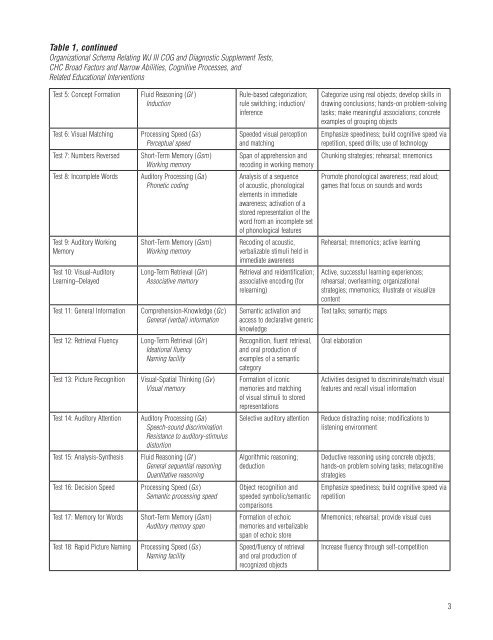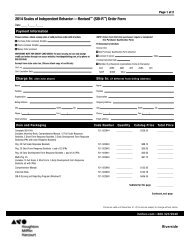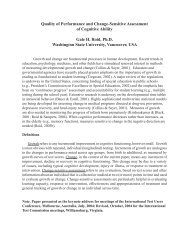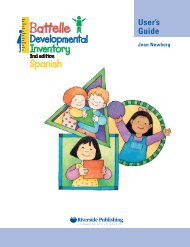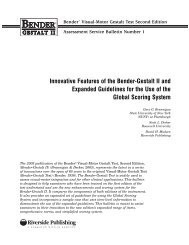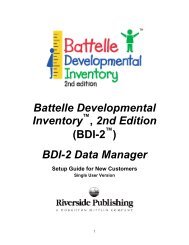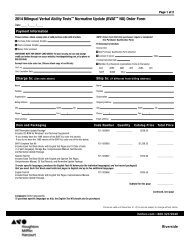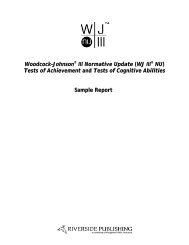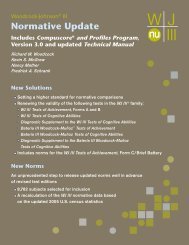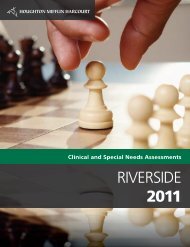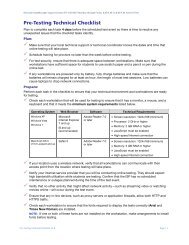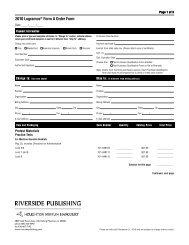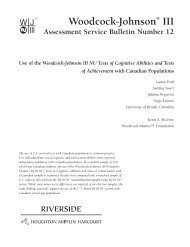Woodcock- Johnson III Tests of Cognitive Abilities - Riverside ...
Woodcock- Johnson III Tests of Cognitive Abilities - Riverside ...
Woodcock- Johnson III Tests of Cognitive Abilities - Riverside ...
Create successful ePaper yourself
Turn your PDF publications into a flip-book with our unique Google optimized e-Paper software.
Table 1, continuedOrganizational Schema Relating WJ <strong>III</strong> COG and Diagnostic Supplement <strong>Tests</strong>,CHC Broad Factors and Narrow <strong>Abilities</strong>, <strong>Cognitive</strong> Processes, andRelated Educational InterventionsTest 5: Concept Formation Fluid Reasoning (Gf )InductionTest 6: Visual Matching Processing Speed (Gs )Perceptual speedTest 7: Numbers Reversed Short-Term Memory (Gsm )Working memoryTest 8: Incomplete Words Auditory Processing (Ga )Phonetic codingTest 9: Auditory WorkingMemoryTest 10: Visual-AuditoryLearning–DelayedShort-Term Memory (Gsm )Working memoryLong-Term Retrieval (Glr )Associative memoryTest 11: General Information Comprehension-Knowledge (Gc )General (verbal) informationTest 12: Retrieval Fluency Long-Term Retrieval (Glr )Ideational fluencyNaming facilityTest 13: Picture Recognition Visual-Spatial Thinking (Gv )Visual memoryTest 14: Auditory Attention Auditory Processing (Ga )Speech-sound discriminationResistance to auditory-stimulusdistortionTest 15: Analysis-Synthesis Fluid Reasoning (Gf )General sequential reasoningQuantitative reasoningTest 16: Decision Speed Processing Speed (Gs )Semantic processing speedTest 17: Memory for Words Short-Term Memory (Gsm )Auditory memory spanTest 18: Rapid Picture Naming Processing Speed (Gs )Naming facilityRule-based categorization;rule switching; induction/inferenceSpeeded visual perceptionand matchingSpan <strong>of</strong> apprehension andrecoding in working memoryAnalysis <strong>of</strong> a sequence<strong>of</strong> acoustic, phonologicalelements in immediateawareness; activation <strong>of</strong> astored representation <strong>of</strong> theword from an incomplete set<strong>of</strong> phonological featuresRecoding <strong>of</strong> acoustic,verbalizable stimuli held inimmediate awarenessRetrieval and reidentification;associative encoding (forrelearning)Semantic activation andaccess to declarative genericknowledgeRecognition, fluent retrieval,and oral production <strong>of</strong>examples <strong>of</strong> a semanticcategoryFormation <strong>of</strong> iconicmemories and matching<strong>of</strong> visual stimuli to storedrepresentationsSelective auditory attentionAlgorithmic reasoning;deductionObject recognition andspeeded symbolic/semanticcomparisonsFormation <strong>of</strong> echoicmemories and verbalizablespan <strong>of</strong> echoic storeSpeed/fluency <strong>of</strong> retrievaland oral production <strong>of</strong>recognized objectsCategorize using real objects; develop skills indrawing conclusions; hands-on problem-solvingtasks; make meaningful associations; concreteexamples <strong>of</strong> grouping objectsEmphasize speediness; build cognitive speed viarepetition, speed drills; use <strong>of</strong> technologyChunking strategies; rehearsal; mnemonicsPromote phonological awareness; read aloud;games that focus on sounds and wordsRehearsal; mnemonics; active learningActive, successful learning experiences;rehearsal; overlearning; organizationalstrategies; mnemonics; illustrate or visualizecontentText talks; semantic mapsOral elaborationActivities designed to discriminate/match visualfeatures and recall visual informationReduce distracting noise; modifications tolistening environmentDeductive reasoning using concrete objects;hands-on problem solving tasks; metacognitivestrategiesEmphasize speediness; build cognitive speed viarepetitionMnemonics; rehearsal; provide visual cuesIncrease fluency through self-competition


